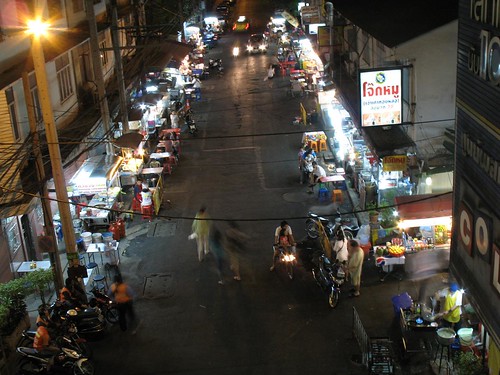Cool Barbecue Foods images
A few nice barbecue foods images I found:
Barbecue Bacon Cheddar Grilled Cheese

Image by tubedogg
Barbecue Bacon Cheddar Grilled Cheese

Image by tubedogg
Barbecue Bacon Cheddar Grilled Cheese

Image by tubedogg
Street Food @ Thonglor
Some cool barbecue foods images:
Street Food @ Thonglor

Image by invisiblewaves
From light fares like rice porridge and Wonton soup to roast duck, barbecue pork, noodles with real crab meat, and anything made per order.
Barbecue Chicken Pizza

Image by jumanggy
For more, go to No Special Effects.
barbecue from Pappy’s
A few nice barbecue foods images I found:
barbecue from Pappy’s

Image by MBK (Marjie)
one-third of the full slab of ribs, with the sweet bbq sauce and sweet potato fries
Dinner, 9/17: Food!

Image by Church of the Redeemer
Corn on the cob, barbecued salmon and chicken. Mmmm.
Barbecue

Image by revrev
Nice Healthy Food Choices photos
Some cool healthy food choices images:
2012 Soil Health Information Day, Mitchell, SD

Image by NRCS SD
FOCUS FOR AG FUTURE: SOIL BIOLOGY AS “NEW FRONTIER”
NATURAL RESOURCES CONSERVATION SERVICE (NRCS), Pierre, SD, December 14, 2012—The inherent and dynamic qualities of soil were in the spotlight at the Soil Health Information Day held December 11, 2012 in Mitchell, SD. The event attracted over 230 people to hear regional and national agriculture and natural resources speakers.
Ruth Beck, SDSU Extension Agronomy Field Specialist, Pierre, says “One goal with the event was to help people learn ways to manage soil that improve the soil function. Although we can’t change the inherent qualities of the soil in our yards, fields and pastures, we can make management choices that affect the amount of organic matter, structure, depth, water and nutrient-holding capacity—the indicators of the health of a soil.”
“While the physical and chemical properties of soil have long been a main factor for land use planning, we are now getting an understanding of the biology happening beneath our feet,” says Colette Kessler, Public Affairs Specialist with the USDA Natural Resources Conservation Service (NRCS), Pierre. “Thanks to technology advances in microscopes and other equipment, our ‘understanding’ of the science of soil, biology in particular, has grown more in the last three years than the last 30,” she explains.
Two Alpena area farmers were enlisted to kick off the day demonstrating water infiltration with Ray Archuleta, Conservation Agronomist, from the NRCS East National Technical Center, Greensboro, NC. “Look at this…it isn’t a problem of run-off; we have an infiltration problem,” said Archuleta as the audience watched him work through the soil experiment. “Ray the Soil Guy” got to the ‘root’ of everyone’s questions with his presentation “Healthy Soils Make Healthy Profits.” Archuleta is passionate about soil health and his passion is infectious. He specializes in soil biology/ecology and diversity approaches for agro-ecosystem sustainability. “Understanding the biology—the microbes—in the soil is the ‘next step’ for farmers and ranchers,” says Archuleta. Every operation is unique. He outlined how to use above-ground management, such as crop rotations, cover crops, and reducing tillage as tools to manipulate the soil biology for a more sustainable system.
“A healthy soil is not compacted. It has structure with macro pores that allow water to infiltrate down into the profile,” Archuleta explained earlier. “When I pick up a shovelful of soil, it should look like cottage cheese.” Jim Hoorman, Ohio State University, via webinar, outlined their university research findings and the economics of using mixes of cover crops to improve the problem of compacted soils. Mixtures are better for addressing compaction than using a single cover crop species. Hoorman explained that disturbances, like tillage, can destroy pore structure in a soil. Good pore structure is very important, allowing the soil to breathe and move water.
“Healthy soil regulates water well,” explained Paul Jasa, Extension Engineer, University of Nebraska-Lincoln. Soil and residue management helps control where rain, snowmelt and irrigation water goes. “Field after field,” he says, “Residue drives the crop. Buffers are good, but a ‘band-aid;’ fix the soil in the field with residue and keep your water,” says Jasa. “Go out with a spade and see for yourself how your soil is handling water.”
Internationally known Dr. Dwayne Beck, Manager, SDSU Dakota Lakes Research Farm near Pierre, encourages producers to mimic nature, “I’ve learned more from observing nature than trying to change it.” Crop residue helps improve the soils balance of nutrients like nitrogen and phosphorus. Beck’s presentation outlined ‘Catch and Release Nutrients’ and working with natural cycles to maximize crop production. “Plant roots are ‘hot spots’ for biological activities like nutrient cycling and soil aggregate stability,” says Beck. Both living roots, and the dead or dying roots, improve water infiltration and break up compacted soils. An abundance of roots helps to stabilize biological activities below ground, making more nutrients and water available to plants.
A common theme recommended throughout the day was for people to get out in their yards, fields and pastures with a shovel. “If we dig a little, we can learn a lot,” says Kessler, “We can better understand how healthy soil should look and smell, and how healthy soil should feel in our hands.” By the year 2050, Earth’s population is expected to reach 9 billion. Keeping every inch of our soil healthy will be essential as farmers and ranchers work to produce as much food and fiber in the next 40 years as they have in the last 500.
Photos showing Soil health can also be found at: www.flickr.com/photos/87743206@N04/
2012 Soil Health Information Day, Mitchell, SD

Image by NRCS SD
FOCUS FOR AG FUTURE: SOIL BIOLOGY AS “NEW FRONTIER”
NATURAL RESOURCES CONSERVATION SERVICE (NRCS), Pierre, SD, December 14, 2012—The inherent and dynamic qualities of soil were in the spotlight at the Soil Health Information Day held December 11, 2012 in Mitchell, SD. The event attracted over 230 people to hear regional and national agriculture and natural resources speakers.
Ruth Beck, SDSU Extension Agronomy Field Specialist, Pierre, says “One goal with the event was to help people learn ways to manage soil that improve the soil function. Although we can’t change the inherent qualities of the soil in our yards, fields and pastures, we can make management choices that affect the amount of organic matter, structure, depth, water and nutrient-holding capacity—the indicators of the health of a soil.”
“While the physical and chemical properties of soil have long been a main factor for land use planning, we are now getting an understanding of the biology happening beneath our feet,” says Colette Kessler, Public Affairs Specialist with the USDA Natural Resources Conservation Service (NRCS), Pierre. “Thanks to technology advances in microscopes and other equipment, our ‘understanding’ of the science of soil, biology in particular, has grown more in the last three years than the last 30,” she explains.
Two Alpena area farmers were enlisted to kick off the day demonstrating water infiltration with Ray Archuleta, Conservation Agronomist, from the NRCS East National Technical Center, Greensboro, NC. “Look at this…it isn’t a problem of run-off; we have an infiltration problem,” said Archuleta as the audience watched him work through the soil experiment. “Ray the Soil Guy” got to the ‘root’ of everyone’s questions with his presentation “Healthy Soils Make Healthy Profits.” Archuleta is passionate about soil health and his passion is infectious. He specializes in soil biology/ecology and diversity approaches for agro-ecosystem sustainability. “Understanding the biology—the microbes—in the soil is the ‘next step’ for farmers and ranchers,” says Archuleta. Every operation is unique. He outlined how to use above-ground management, such as crop rotations, cover crops, and reducing tillage as tools to manipulate the soil biology for a more sustainable system.
“A healthy soil is not compacted. It has structure with macro pores that allow water to infiltrate down into the profile,” Archuleta explained earlier. “When I pick up a shovelful of soil, it should look like cottage cheese.” Jim Hoorman, Ohio State University, via webinar, outlined their university research findings and the economics of using mixes of cover crops to improve the problem of compacted soils. Mixtures are better for addressing compaction than using a single cover crop species. Hoorman explained that disturbances, like tillage, can destroy pore structure in a soil. Good pore structure is very important, allowing the soil to breathe and move water.
“Healthy soil regulates water well,” explained Paul Jasa, Extension Engineer, University of Nebraska-Lincoln. Soil and residue management helps control where rain, snowmelt and irrigation water goes. “Field after field,” he says, “Residue drives the crop. Buffers are good, but a ‘band-aid;’ fix the soil in the field with residue and keep your water,” says Jasa. “Go out with a spade and see for yourself how your soil is handling water.”
Internationally known Dr. Dwayne Beck, Manager, SDSU Dakota Lakes Research Farm near Pierre, encourages producers to mimic nature, “I’ve learned more from observing nature than trying to change it.” Crop residue helps improve the soils balance of nutrients like nitrogen and phosphorus. Beck’s presentation outlined ‘Catch and Release Nutrients’ and working with natural cycles to maximize crop production. “Plant roots are ‘hot spots’ for biological activities like nutrient cycling and soil aggregate stability,” says Beck. Both living roots, and the dead or dying roots, improve water infiltration and break up compacted soils. An abundance of roots helps to stabilize biological activities below ground, making more nutrients and water available to plants.
A common theme recommended throughout the day was for people to get out in their yards, fields and pastures with a shovel. “If we dig a little, we can learn a lot,” says Kessler, “We can better understand how healthy soil should look and smell, and how healthy soil should feel in our hands.” By the year 2050, Earth’s population is expected to reach 9 billion. Keeping every inch of our soil healthy will be essential as farmers and ranchers work to produce as much food and fiber in the next 40 years as they have in the last 500.
Photos showing Soil health can also be found at: www.flickr.com/photos/87743206@N04/
2012 Soil Health Information Day, Mitchell, SD

Image by NRCS SD
Vender Area
FOCUS FOR AG FUTURE: SOIL BIOLOGY AS “NEW FRONTIER”
NATURAL RESOURCES CONSERVATION SERVICE (NRCS), Pierre, SD, December 14, 2012—The inherent and dynamic qualities of soil were in the spotlight at the Soil Health Information Day held December 11, 2012 in Mitchell, SD. The event attracted over 230 people to hear regional and national agriculture and natural resources speakers.
Ruth Beck, SDSU Extension Agronomy Field Specialist, Pierre, says “One goal with the event was to help people learn ways to manage soil that improve the soil function. Although we can’t change the inherent qualities of the soil in our yards, fields and pastures, we can make management choices that affect the amount of organic matter, structure, depth, water and nutrient-holding capacity—the indicators of the health of a soil.”
“While the physical and chemical properties of soil have long been a main factor for land use planning, we are now getting an understanding of the biology happening beneath our feet,” says Colette Kessler, Public Affairs Specialist with the USDA Natural Resources Conservation Service (NRCS), Pierre. “Thanks to technology advances in microscopes and other equipment, our ‘understanding’ of the science of soil, biology in particular, has grown more in the last three years than the last 30,” she explains.
Two Alpena area farmers were enlisted to kick off the day demonstrating water infiltration with Ray Archuleta, Conservation Agronomist, from the NRCS East National Technical Center, Greensboro, NC. “Look at this…it isn’t a problem of run-off; we have an infiltration problem,” said Archuleta as the audience watched him work through the soil experiment. “Ray the Soil Guy” got to the ‘root’ of everyone’s questions with his presentation “Healthy Soils Make Healthy Profits.” Archuleta is passionate about soil health and his passion is infectious. He specializes in soil biology/ecology and diversity approaches for agro-ecosystem sustainability. “Understanding the biology—the microbes—in the soil is the ‘next step’ for farmers and ranchers,” says Archuleta. Every operation is unique. He outlined how to use above-ground management, such as crop rotations, cover crops, and reducing tillage as tools to manipulate the soil biology for a more sustainable system.
“A healthy soil is not compacted. It has structure with macro pores that allow water to infiltrate down into the profile,” Archuleta explained earlier. “When I pick up a shovelful of soil, it should look like cottage cheese.” Jim Hoorman, Ohio State University, via webinar, outlined their university research findings and the economics of using mixes of cover crops to improve the problem of compacted soils. Mixtures are better for addressing compaction than using a single cover crop species. Hoorman explained that disturbances, like tillage, can destroy pore structure in a soil. Good pore structure is very important, allowing the soil to breathe and move water.
“Healthy soil regulates water well,” explained Paul Jasa, Extension Engineer, University of Nebraska-Lincoln. Soil and residue management helps control where rain, snowmelt and irrigation water goes. “Field after field,” he says, “Residue drives the crop. Buffers are good, but a ‘band-aid;’ fix the soil in the field with residue and keep your water,” says Jasa. “Go out with a spade and see for yourself how your soil is handling water.”
Internationally known Dr. Dwayne Beck, Manager, SDSU Dakota Lakes Research Farm near Pierre, encourages producers to mimic nature, “I’ve learned more from observing nature than trying to change it.” Crop residue helps improve the soils balance of nutrients like nitrogen and phosphorus. Beck’s presentation outlined ‘Catch and Release Nutrients’ and working with natural cycles to maximize crop production. “Plant roots are ‘hot spots’ for biological activities like nutrient cycling and soil aggregate stability,” says Beck. Both living roots, and the dead or dying roots, improve water infiltration and break up compacted soils. An abundance of roots helps to stabilize biological activities below ground, making more nutrients and water available to plants.
A common theme recommended throughout the day was for people to get out in their yards, fields and pastures with a shovel. “If we dig a little, we can learn a lot,” says Kessler, “We can better understand how healthy soil should look and smell, and how healthy soil should feel in our hands.” By the year 2050, Earth’s population is expected to reach 9 billion. Keeping every inch of our soil healthy will be essential as farmers and ranchers work to produce as much food and fiber in the next 40 years as they have in the last 500.
Photos showing Soil health can also be found at: www.flickr.com/photos/87743206@N04/
Cool Barbecue Foods images
A few nice barbecue foods images I found:
Miniature Food – Barbecue Plate D

Image by PetitPlat – Stephanie Kilgast
Soleil + Chaleur = barbecue!
Sun + Hot Weather = barbecue!
handmade by me out of polymer clay
1:12 dolllhouse scale

